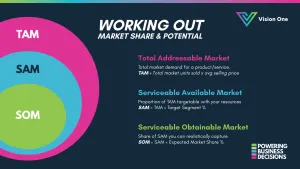TAM SAM SOM Framework
| Acronym | Definition | Why It Matters |
|---|---|---|
| TAM (Total Addressable Market) | The maximum revenue if you had 100% market share | Shows the full scale of the opportunity |
| SAM (Serviceable Available Market) | The part of TAM that fits your product and geography | Helps you target the right customers |
| SOM (Serviceable Obtainable Market) | The share of SAM you can realistically win | Turns ambition into actionable targets |

Three Steps to Calculate Market Size
Step 1: Define Your Target Market
Map TAM SAM and SOM clearly. Be specific about geography product and customer segments.
Step 2: Gather Supporting Market Intelligence
Use three main data sources:
-
Secondary research: Industry reports, government data, competitor analysis
-
Primary research: Customer surveys, interviews, pilot programs
-
Company data: Sales records, customer behaviour, conversion metrics
Market research tools such as brand tracking, usage and sentiment analysis, or concept testing surveys can validate assumptions quickly. For example, testing demand with 500 consumers before launch can save costly mistakes.
Step 3: Apply the Market Size Formula
Market Size = Number of Target Customers × Average Revenue per Customer
For example, if 500,000 customers each spend £120 per year, the market size is £60 million.
Projecting Growth
Do not just calculate today. Project future growth by:
-
Reviewing historical demand trends
-
Factoring in market growth and new geographies
-
Considering competition and barriers to entry
-
Forecasting across 1, 3, and 5-year horizons
Final Market Size Checklist
-
Define TAM SAM SOM
-
Use both Top-Down and Bottom-Up approaches
-
Support with credible data
-
State your assumptions clearly
-
Consider growth scenarios
Conclusion
Calculating market size gives scale ups the clarity to make confident strategic decisions. Use both Top-Down and Bottom-Up methods, refine with TAM SAM SOM, and support assumptions with real market research.
If you want to validate your numbers, our market research solutions such as brand tracking and concept testing, can help you stress-test your assumptions before you scale.

